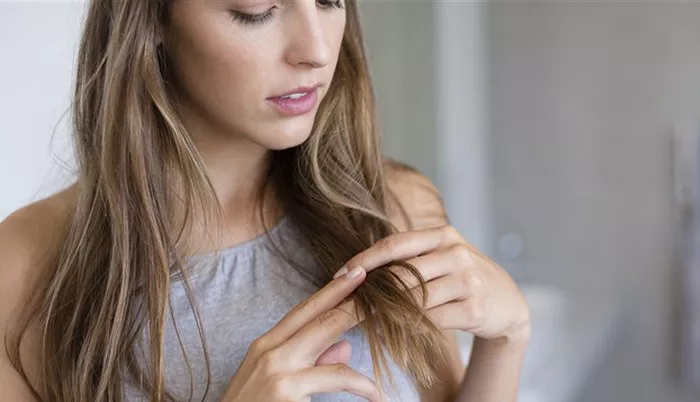When the tips of your hair show “Y”-shaped or tree branch-like cracks, it indicates that the hair has entered an irreversible damage stage.
Each hair is composed of three layers:
- The outermost layer is the transparent, scale-like cuticle (hair scale).
- The middle layer is the cortex, which determines the color of the hair.
- The innermost layer is the medullary layer.
Daily combing causes mechantion that makes the cuticles stand up. Hot water washing accelerates protein loss, and perming and dyeing agents directly dissolve the cuticle layer.
When these damages accumulate to a critical point, the most vulnerable ends of the hair will crack longituical fricdinally, forming split ends. According to a study by the American Academy of Dermatology, over 90% of adult women have split ends, and among those who frequently perm and dye their hair, the incidence rate of split ends is as high as 97%.
Why Can’t Split Ends Be Truly Repaired?
Irreversible physical structure: Split ends are like cracks on porcelain. Broken keratin fibers cannot be re-bonded. Products on the market that claim to “repair split ends” actually only temporarily coat the hair with silicone oil, just like sticking broken glass together with tape.
Nutrients cannot penetrate: Damaged hair strands have lost their normal absorption capacity. The protein molecules in hair conditioner (with an average molecular weight of 5,000 daltons) are far larger than the gaps between healthy cuticles (about 25 nanometers), making it impossible for them to enter the hair core.
Permanent breakage of chemical bonds: The disulfide bonds in hair (a key structure determining hair elasticity) can break under high temperatures or chemical treatments. Once these chemical bonds are disrupted, they cannot be naturally reformed.
Experimental data shows that after using a certain brand’s repair essence for 8 weeks, the number of split ends only decreased by 3.2%, while the control group (only trimming) saw a 100% reduction in split ends. This proves that the current technology cannot truly repair already formed split ends.
5 Effective Prevention Schemes
Scientific Hair Washing Techniques
Control the water temperature at 38℃ (slightly cool to the touch)
Lather up the shampoo before applying it to your hair.
Massage with the pads of your fingers rather than scratching with your nails.
The rinsing time should be no less than 2 minutes.
Advanced Hair Care Routine
Hair Care Steps Usage Frequency Key Ingredients
Pre-wash Treatment Once a week Coconut oil / Jojoba oil
Hair Mask Treatment Twice a week Hydrolyzed keratin
Leave-in Essence Daily use Ceramide
Guidelines for Using Heat Tools
Keep the hair dryer 30 cm away and move it while blowing.
The temperature of the straightening iron should not exceed 180℃ for fine and soft hair or 200℃ for coarse and hard hair.
Be sure to spray a heat-resistant spray containing silane before use.
Physical protective measures
Silk pillowcases reduce friction at night
A wide-toothed comb instead of a fine-toothed comb.
Change the high ponytail to a telephone cord hair tie.
Wear a silicone swimming cap when swimming.
Internal health preservation plan
Supplement 5mg of biotin (vitamin H) daily.
Consume eggs and beef that contain cystine.
Ensure 7 hours of deep sleep.
Thirty minutes of aerobic exercise three times a week.
Analysis of Common Misconceptions
Misconception 1: Frequent haircuts can prevent split ends.
Truth: Trimming 0.5 cm every 8 weeks can only control the spread of split ends but cannot prevent new ones from forming.
Misconception 2: Expensive hair care products are more effective
Experiments have shown that the difference in preventing split ends between a 30-yuan and a 300-yuan conditioner is less than 5%.
Myth 3: Air-drying is better for hair than blow-drying
Hair expands when wet and is more prone to breakage. Correct blow-drying actually reduces damage.
Professional-level Care Program
Salon-grade keratin treatment can provide 6-8 weeks of protective effect. It involves introducing liquid keratin at high temperatures to form a protective film on the hair surface. However, please note:
It should be used in combination with a sulfate-free shampoo.
The interval between each care session should be no less than 45 days.
Not suitable for severely damaged hair.
Clinical trials of medical-grade laser hair growth caps have shown that after 8 weeks of treatment with 650nm low-intensity laser, the rate of new hair forking decreased by 41%. This photobiomodulation therapy can enhance hair follicle activity, but it requires continuous use.
The Ultimate Solution
When split ends have formed, the only effective method is the “3-Centimeter Trim”:
- Divide the hair into 8 sections.
- Check each strand for split ends.
- Cut diagonally 3 centimeters above the split ends.
- Repeat the check and trim monthly.
Combined with daily care, it can reduce the recurrence rate of split ends by 73%. Remember: Preventing one split end is better than repairing a hundred. Establishing scientific hair care habits is the fundamental way to keep hair healthy.
Conclusion
Hair care is a long-term battle. Instead of chasing after illusory “repair miracles”, it’s better to start now and treat each strand of hair with the right methods. When your care routine becomes a habit, the soft, shiny and smooth hair in the mirror will be the best reward.
Related topics:
Top 5 Conditioners That Work for Every Hair Type
How to Use Conditioner on Afro Hair: A Complete Guide
How to Fix Broken Hair at Roots: Effective Repair Guide


